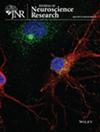James F. McGinnis, Philip L. Stepanik, Sutida Jariangprasert, Valentine Lerious
求助PDF
{"title":"Functional significance of recoverin localization in multiple retina cell types","authors":"James F. McGinnis, Philip L. Stepanik, Sutida Jariangprasert, Valentine Lerious","doi":"10.1002/(SICI)1097-4547(19971101)50:3<487::AID-JNR15>3.0.CO;2-3","DOIUrl":null,"url":null,"abstract":"<p>Knowledge of the cellular localization of recoverin in photoreceptor cells has enabled its interaction with other proteins to be postulated, tested and verified. Recoverin, a calcium sensing protein, is now thought to act by prolongation of the light state through interference with the interaction of arrestin and rhodopsin. Because of the detection of recoverin in multiple cell populations, the specificity of the cellular localization of recoverin was investigated in the retina of the mouse, rat, rabbit, chicken, frog, and chameleon and compared to that for opsin, phosducin, and arrestin. In addition to photoreceptor cell staining, the application of affinity-purified antibodies against recoverin demonstrated immunoreactive cells in the inner nuclear layer and a rare immunopositive cell in the ganglion cell layer of the mouse, rat and rabbit retina. Only photoreceptor cells were stained with recoverin antibodies in the chameleon and frog retina, whereas no cells were recoverin-positive in the chicken retina. In all six species studied, only photoreceptor cells were labelled with antibodies against opsin, phosducin or arrestin. Based on intensity of staining, two distinct populations of anti-recoverin-immunoreactive cells were distinguished in the photoreceptor cell layer of the retinas of the rat and rabbit, with the more darkly stained cells (probably cones) representing about 3% of the photoreceptor cells. The presence of recoverin in cells other than photoreceptors suggests it has an alternative or additional function and indicates the presence of multiple cell type-specific expression signals in the regulatory region of the recoverin gene. J. Neurosci. Res. 50:487–495, 1997. © 1997 Wiley-Liss, Inc.</p>","PeriodicalId":16490,"journal":{"name":"Journal of Neuroscience Research","volume":"50 3","pages":"487-495"},"PeriodicalIF":3.4000,"publicationDate":"1998-12-07","publicationTypes":"Journal Article","fieldsOfStudy":null,"isOpenAccess":false,"openAccessPdf":"","citationCount":"42","resultStr":null,"platform":"Semanticscholar","paperid":null,"PeriodicalName":"Journal of Neuroscience Research","FirstCategoryId":"3","ListUrlMain":"https://onlinelibrary.wiley.com/doi/10.1002/%28SICI%291097-4547%2819971101%2950%3A3%3C487%3A%3AAID-JNR15%3E3.0.CO%3B2-3","RegionNum":3,"RegionCategory":"医学","ArticlePicture":[],"TitleCN":null,"AbstractTextCN":null,"PMCID":null,"EPubDate":"","PubModel":"","JCR":"Q2","JCRName":"NEUROSCIENCES","Score":null,"Total":0}
引用次数: 42
引用
批量引用
Abstract
Knowledge of the cellular localization of recoverin in photoreceptor cells has enabled its interaction with other proteins to be postulated, tested and verified. Recoverin, a calcium sensing protein, is now thought to act by prolongation of the light state through interference with the interaction of arrestin and rhodopsin. Because of the detection of recoverin in multiple cell populations, the specificity of the cellular localization of recoverin was investigated in the retina of the mouse, rat, rabbit, chicken, frog, and chameleon and compared to that for opsin, phosducin, and arrestin. In addition to photoreceptor cell staining, the application of affinity-purified antibodies against recoverin demonstrated immunoreactive cells in the inner nuclear layer and a rare immunopositive cell in the ganglion cell layer of the mouse, rat and rabbit retina. Only photoreceptor cells were stained with recoverin antibodies in the chameleon and frog retina, whereas no cells were recoverin-positive in the chicken retina. In all six species studied, only photoreceptor cells were labelled with antibodies against opsin, phosducin or arrestin. Based on intensity of staining, two distinct populations of anti-recoverin-immunoreactive cells were distinguished in the photoreceptor cell layer of the retinas of the rat and rabbit, with the more darkly stained cells (probably cones) representing about 3% of the photoreceptor cells. The presence of recoverin in cells other than photoreceptors suggests it has an alternative or additional function and indicates the presence of multiple cell type-specific expression signals in the regulatory region of the recoverin gene. J. Neurosci. Res. 50:487–495, 1997. © 1997 Wiley-Liss, Inc.
恢复定位在多种视网膜细胞类型中的功能意义
光感受器细胞中恢复素的细胞定位知识使其与其他蛋白质的相互作用得以假设、测试和验证。恢复蛋白是一种钙感应蛋白,现在被认为是通过干扰阻滞蛋白和视紫红质的相互作用来延长光态。由于在多种细胞群中检测到recoverin,我们在小鼠、大鼠、兔、鸡、青蛙和变色龙的视网膜中研究了recoverin的细胞定位特异性,并与opsin、phoducin和arretin进行了比较。除光感受器细胞染色外,应用亲和纯化的抗recoverin抗体在小鼠、大鼠和兔视网膜的内核层发现免疫反应细胞,在神经节细胞层发现罕见的免疫阳性细胞。在变色龙和青蛙视网膜中,只有光感受器细胞被恢复抗体染色,而在鸡视网膜中没有细胞被恢复抗体阳性。在研究的所有六个物种中,只有光感受器细胞被标记有抗视蛋白、光导蛋白或阻滞蛋白的抗体。根据染色强度,在大鼠和兔视网膜的感光细胞层中区分出两种不同的抗恢复免疫反应细胞群,染色较深的细胞(可能是锥细胞)约占感光细胞的3%。在光感受器以外的细胞中,recoverin的存在表明它具有替代或额外的功能,并表明在recoverin基因的调控区域存在多种细胞类型特异性表达信号。j . >。代上50:487-495,1997。©1997 Wiley-Liss, Inc
本文章由计算机程序翻译,如有差异,请以英文原文为准。

 求助内容:
求助内容: 应助结果提醒方式:
应助结果提醒方式:


